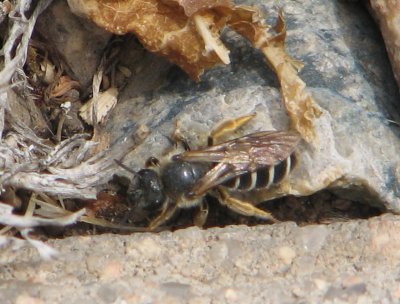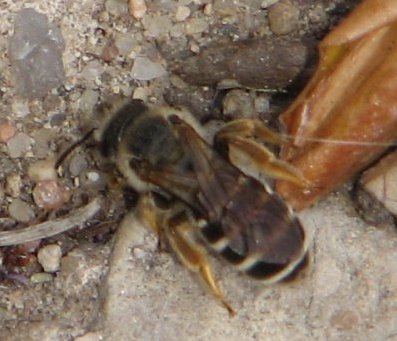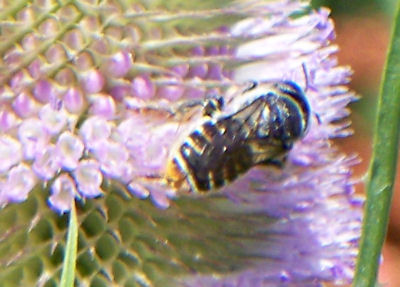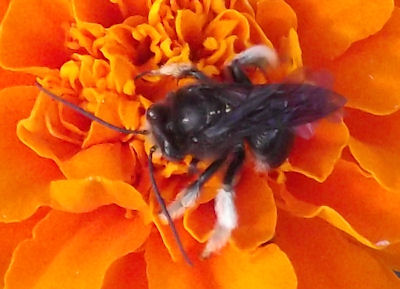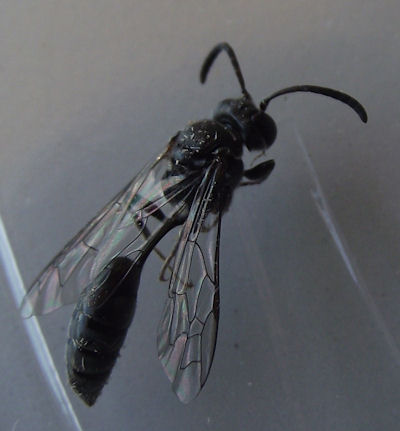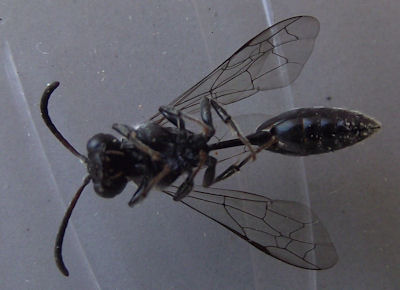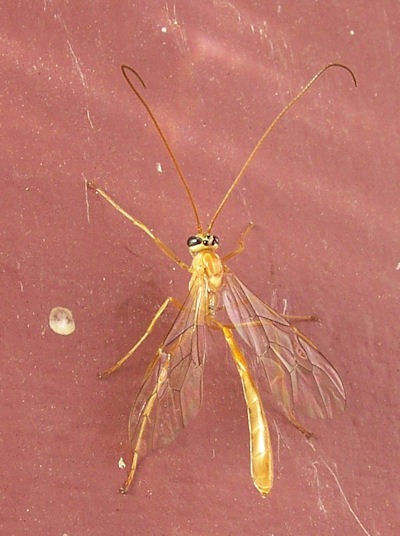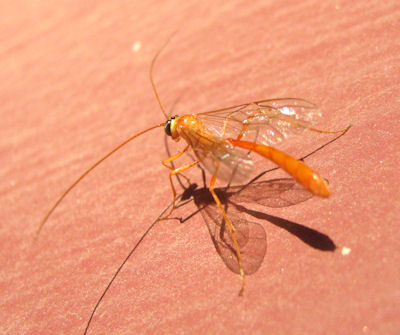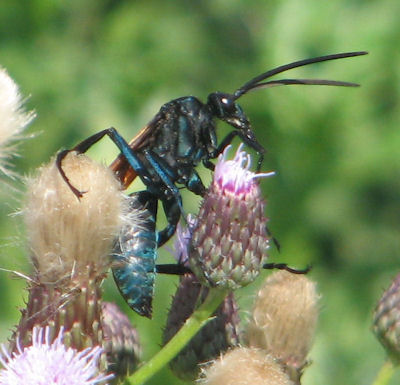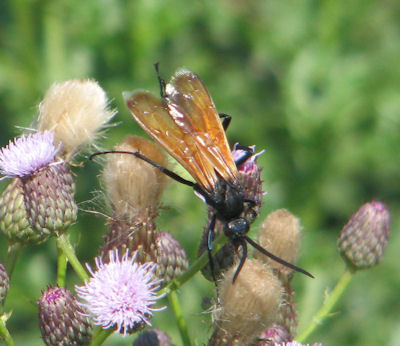| Pavement ants (Tetramorium caespitum) commonly make their
nests around foundations, under rocks and in cracks of sidewalks and driveways.
They are a recent arrival to the state but are currently the most common
ant found in homes. They are small ants (1/10 to 1/16 inch) with a dark body,
pale-colored legs and antennae, and a series of grooves on their faces.
Pavement ants forage on a variety of food that includes grease, meat,
small seeds and sweets. (from Wikipedia)
I used a low-power microscope to get these pictures.
Kingdom: Animalia
Phylum: Arthropoda
Class: Insecta
Order: Hymenoptera
Suborder: Apocrita
Superfamily: Vespoidea
Family: Formicidae
Subfamily: Myrmicinae
Genus: Tetramorium
Species: Tetramorium caespitum
| 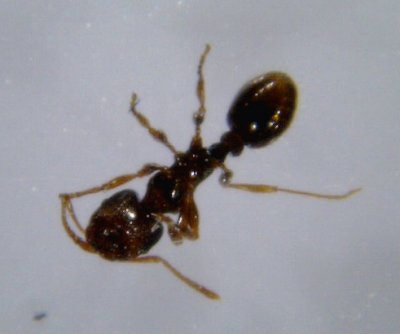
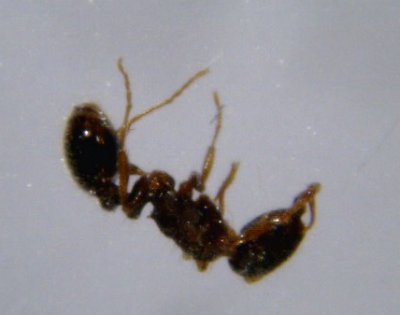
|
These ants are known as a wood ant, mound ant, and field ant.
They are in the genus Formica, and this one is of the species F. pallidefulva,
although the color markings also look like species F. incerta. There is some variablility
in the color and markings in both species.
This picture was taken by Alyssa Erickson. These ants are usually found
in the Eastern U.S., but they have been found in Colorado, per
antbase.org/ants/publications/21293/21293.pdf
Kingdom: Animalia
Phylum: Arthropoda
Class: Insecta
Order: Hymenoptera
Family: Formicidae
Subfamily: Formicinae
Tribe: Formicini
Genus: Formica
Species: pallidefulva
| 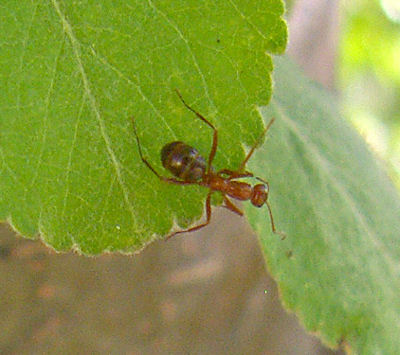
|
| This large black ant is a Carpenter ant.
The Picture was taken on 10 June 2008 in Colorado Springs, CO.
It was accidently injured during the capture process.
Kingdom: Animalia
Phylum: Arthropoda
Class: Insecta
Order: Hymenoptera
Family: Formicidae
Subfamily: Formicinae
Tribe: Camponotini
Genus: Camponotus
There are over a thousand species in the Camponotus Genus, many of them all black.
| 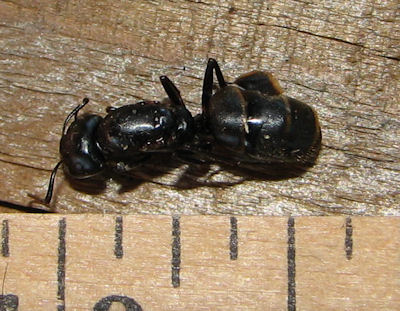
|
| When I first took this picture, I thought it was
a Black Wasp. It was on a Milkweed plant at the Fountain Creek Nature Center on 30 June 2009.
But the more I look at photos and read descriptions, the more I think it is a
Camponotus pennsylvanicus, Black Carpenter Ant.
The rounded rear end looks more like an ant than a wasp.
|
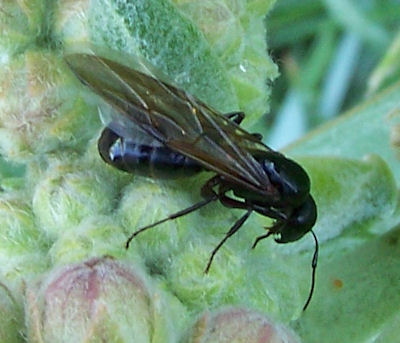
|
| This one was found on 1 July 2009 in my flower bed.
It looks identical to the first Black Carpenter in the photo above, and also identical
to the winged ant next to it. So, I conclude that this is also a Camponotus pennsylvanicus.
It is 1.5 cm long, not counting antenna.
|
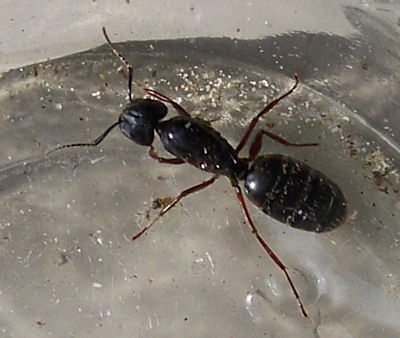
|
| These ants were swarming out of a hole in the ground in our back yard in Colorado Springs on
2 August 2009. They were about 6mm in length, and with very large pinchers.
Conor Kimball furnished some identification down to the genus level,
and thinks that they may be species barbatus (like the next
series of photos) or occidentalis. This genus has a very toxic venom,
according to Wikipedia.
Kingdom: Animalia
Phylum: Arthropoda
Class: Insecta
Order: Hymenoptera
Family: Formicidae
Subfamily: Myrmicinae
Tribe: Myrmicini
Genus: Pogonomyrmex
|
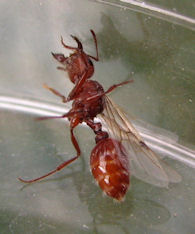
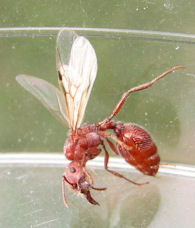
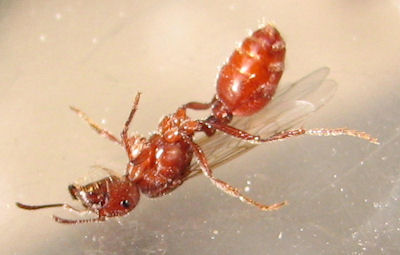
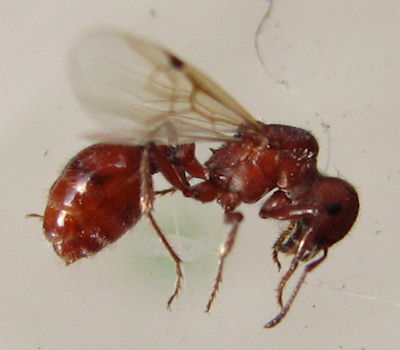
|
| Red harvester ants. These ants mostly collect seeds
in large quantities. They can deliver large numbers of painful bites when agitated.
The second photo is their nest, about 18" across.
Kingdom: Animalia
Phylum: Arthropoda
Class: Insecta
Order: Hymenoptera
Family: Formicidae
Subfamily: Myrmicinae
Tribe: Myrmicini
Genus: Pogonomyrmex
Species: P. barbatus
These pictures were taken on 8 May 2008, near the Fountain, CO Nature Center.
| 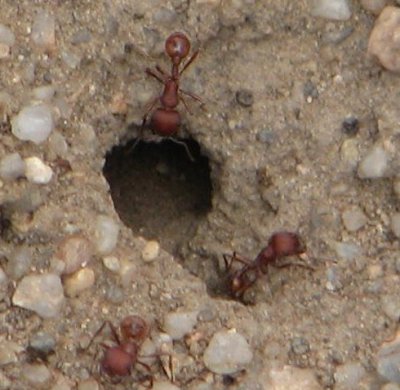
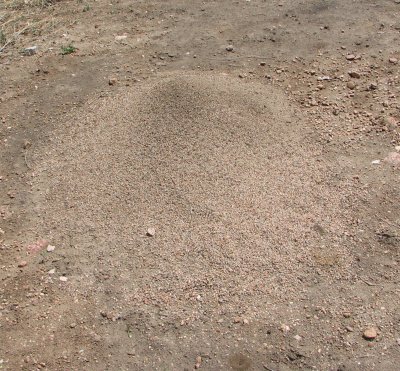
|
| A winged ant. Could be either male or female. I found it with other
ants. Identification is pending. Maybe a Crematogaster queen.
July 5, 2008 in Colorado Springs.
| 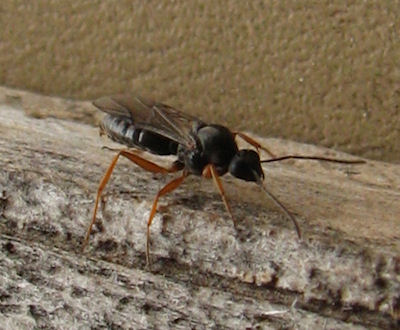
|
| This ant has not been identified yet. It was on a leaf
with a large group of aphids, on 28 September 2011 at the Fountain Creek
Nature Center in Fountain, Colorado.
|
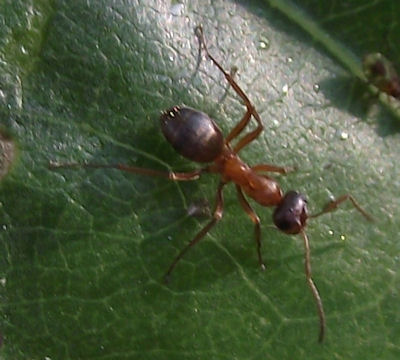
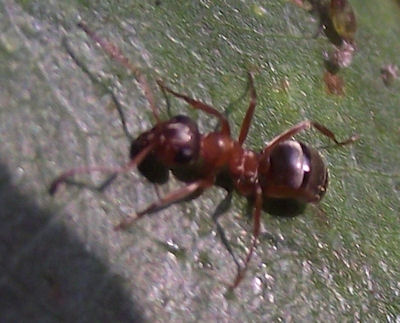
|
| The first two pictures show a Honey bee, Apis mellifera, on a Milkweed plant at the Fountain Creek Nature Center
on 28 June 2009. This one is a worker bee.
The third, fourth and fifth pictures were taken 26 September 2008 in Colorado Springs, CO.
They show one or two more honey bees.
Kingdom: Animalia
Phylum: Arthropoda
Class: Insecta
Subclass: Pterygota
Infraclass: Neoptera
Superorder: Endopterygota
Order: Hymenoptera
Suborder: Apocrita
Family: Apidae
Subfamily: Apinae
Tribe: Apini
Genus: Apis
Species: mellifera
| 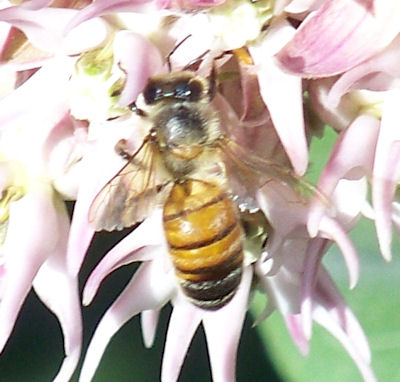
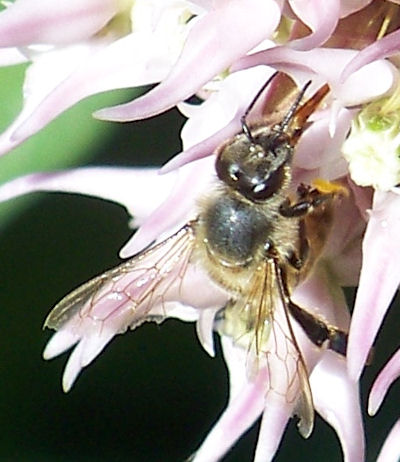
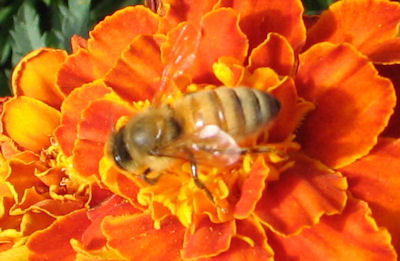
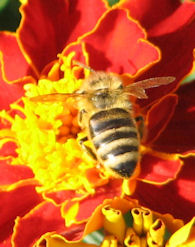
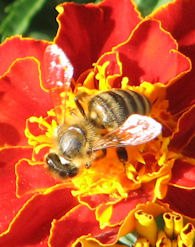
|
| Bumblebee.
These appear to be the Two-spotted Bumblebee, Bombus bimaculatus.
The first two pictures were taken on 20 June and 30 July, 2008, on a Milkweed
plant at the Fountain Creek Nature Center. The third picture was taken on 18 July 2009,
same place.
Kingdom: Animalia
Phylum: Arthropoda
Class: Insecta
Order: Hymenoptera
Family: Apidae
Subfamily: Apinae
Tribe: Bombini
Genus: Bombus
Species: B. bimaculatus (probably, but there are more than 250 species and subspecies in 15 subgenera.)
|
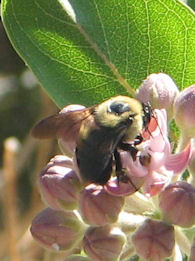
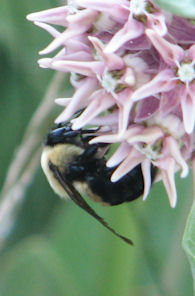
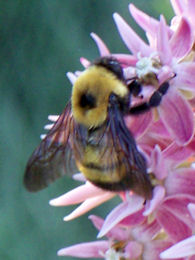
|
| This is another species of Bumble Bee, species Bombus huntii.
Pictures taken 21 September 2008 in Colorado Springs, on a Marigold flower.
Kingdom: Animalia
Phylum: Arthropoda
Class: Insecta
Order: Hymenoptera
Family: Apidae
Subfamily: Apinae
Genus: Bombus
Species: B. huntii
| 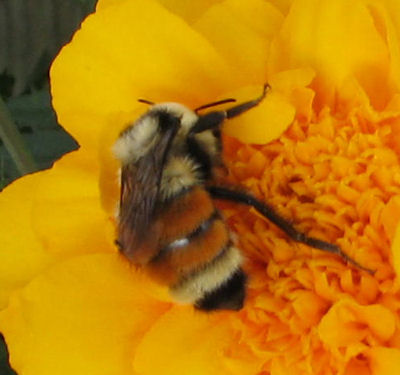
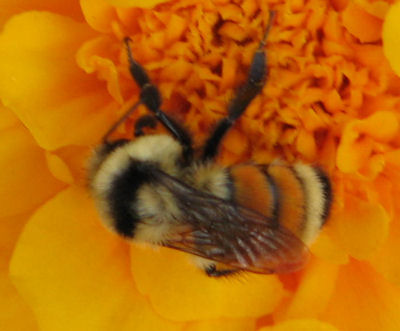
|
| This Bee was photographed by Alyssa Erickson in July 2009.
Identification down to the species level is still pending,
but it appears to be a male in the Genus Melissodes.
This identification was provided by Adalbert Goertz of Colorado Springs CO.
There are many species in this genus, but often it requires a dissection under a microscope
to determine the species.
Kingdom: Animalia
Phylum: Arthropoda
Class: Insecta
Order: Hymenoptera
Family: Apidae
Subfamily: Apinae
Genus: Melissodes
| 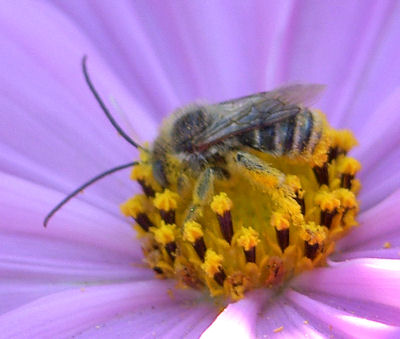
|
| This is a Common Aerial Yellowjacket (Dolichovespula arenaria)
also known as a Sandhill hornet.
Picture taken 20 May 2009 in Colorado Springs, CO. This one is probably a Queen.
Kingdom: Animalia
Phylum: Arthropoda
Class: Insecta
Order: Hymenoptera
Family: Vespidae
Subfamily: Vespinae
Genus: Dolichovespula
Species: arenaria (Common Aerial Yellowjacket)
| 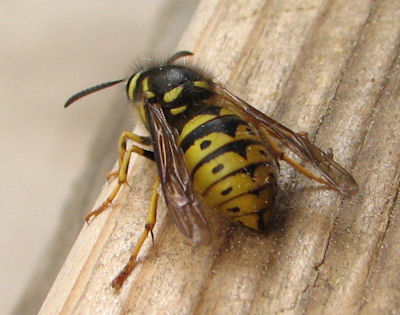
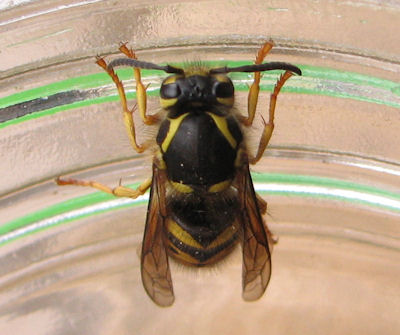
|
| We call this one a Yellow Jacket, but it is actually
a predatory wasp called the European Paper Wasp (Polistes dominulus). It is the most common
of the insects that we call Yellow Jackets.
It originated in Europe, came to New Jersey in 1968, and has spread over the United States since then.
The first picture was taken on August 4, 2008 in El Paso Co., CO.
The second and third photos were taken on 27 July 2009 in Colorado Springs, CO.
The fourth photo was taken on 8 September 2010 at the Fountain Creek Nture Center.
It was sitting on a milkweed plant.
Kingdom: Animalia
Phylum: Arthropoda
Class: Insecta
Order: Hymenoptera
Family: Vespidae
Subfamily: Polistinae
Genus: Polistes
Species: P. dominulus
| 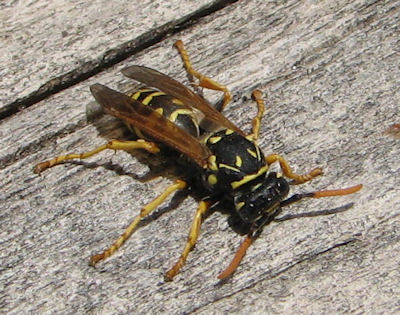
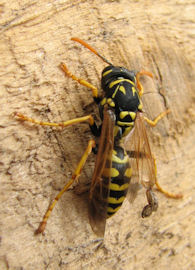
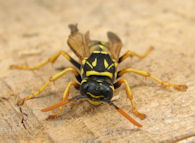
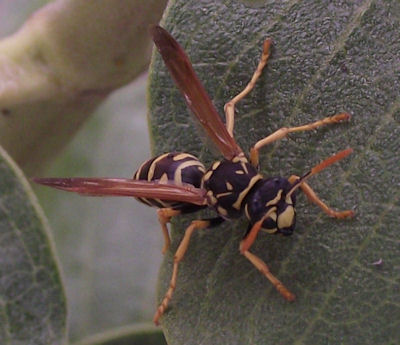
|
| This wasp was found on 22 October 2011 in Colorado Springs.
It was a warm day, so it was flying. It is a Northern Paper Wasp.
Identified by the good folks at www.Bugguide.net
Kingdom: Animalia
Phylum: Arthropoda
Class: Insecta
Order: Hymenoptera
Family: Vespidae
Subfamily: Polistinae
Tribe: Polistini
Genus: Polistes
Species: fuscatus
| 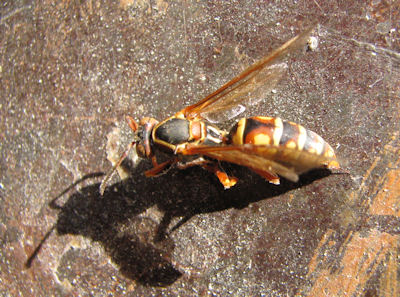
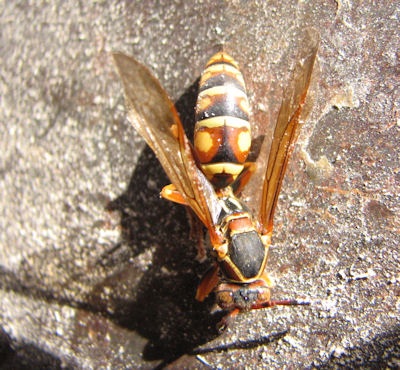
|
| This one is a Yellowjacket. These pictures, taken 15 May 2008 in Colorado Springs,
are of a Prairie Yellowjacket,
Vespula atropilosa, according to some experts on
bugguide.net/node/view/15740.
They say that this species is not common, and these pictures of it are the first to be put on that web site.
This one is a reproductive female.
It looks similar to the Western yellowjacket, Vespula pensylvanica.
This one was not healthy. I found her walking across my garage floor, and she made no
attempt to escape when I picked her up and took her outside for photos. Within an hour after
I finished taking pictures, she curled up and died.
Kingdom: Animalia
Phylum: Arthropoda
Class: Insecta
Order: Hymenoptera
Family: Vespidae
Subfamily: Vespinae
Genus: Vespula
Species: atropilosa
|
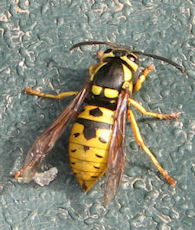
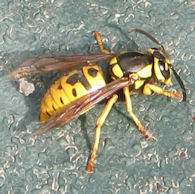
|
| This is a Western Yellowjacket, very common in North America.
This one is a worker.
This picture was taken on 13 November 2008 in Colorado Springs, Colorado.
Kingdom: Animalia
Phylum: Arthropoda
Class: Insecta
Order: Hymenoptera
Family: Vespidae
Subfamily: Vespinae
Genus: Vespula
Species: pensylvanica
| 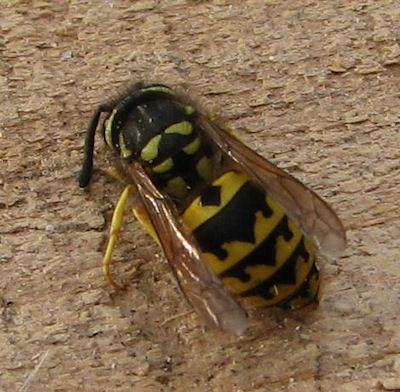
|
| On 17 September 2012, I found a Yellowjacket nest under a large
rock in my neighbor's yard. Large numbers were coming and going through a hole under the rock.
After enlarging pictures, I could identify them as Western Yellowjackets.
| 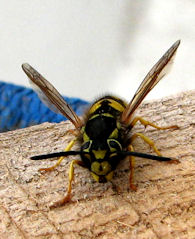
|
| This is probably a Pollen Wasp, found at Fountain Creek, just west of Manitou Springs, CO
on 28 August 2009. It might be a Pseudomasaris edwardsii.
Kingdom: Animalia
Phylum: Arthropoda
Class: Insecta
Order: Hymenoptera
Suborder: Apocrita
Superfamily: Vespoidea
Family: Vespidae
Subfamily: Masarinae
| 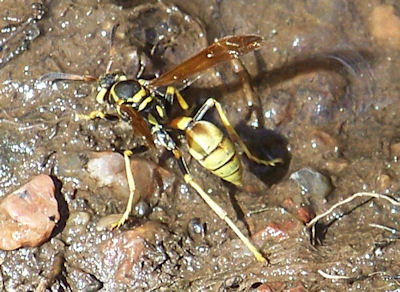
|
| This male wasp, Ancistrocerus tuberculocephalus, was found on 29 April 2012 in Colorado Springs.
It was about 1.3 cm in length. It escaped after this photo. The identification was by the experts on
www.Bugguide.net.
Kingdom: Animalia
Phylum: Arthropoda
Class: Insecta
Order: Hymenoptera
Suborder: Apocrita
Superfamily: Vespoidea
Family: Vespidae
Subfamily: Eumeninae (Potter and Mason Wasps)
Genus: Ancistrocerus
Species: tuberculocephalus
| 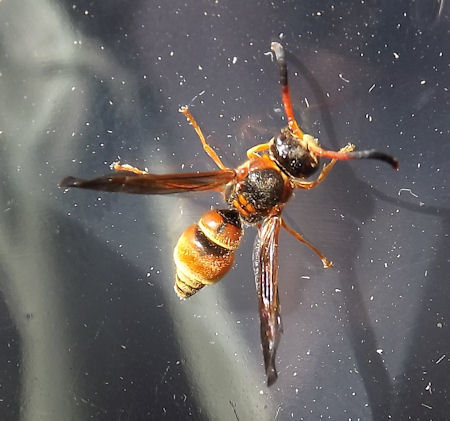
|
| This nest was found on the bottom side of a railroad tie which had
been used for landscaping, and was well rotted. When it was turned over, the
nest was still intact. A slight touch caused the outer paper shell to break in half.
It had been a little larger than a ping-pong ball.
The picture was taken on 30 June 2009 in Colorado springs, CO.
Eric R. Eaton, on
bugguide.net/node/view/324660#499708 says that this is an
"Embryonic "queen nest," probably built by one of the subterranean species
in the genus Vespula. All Vespinae construct a paper envelope over the paper comb like this.
The envelope has several layers in more mature nests."
| 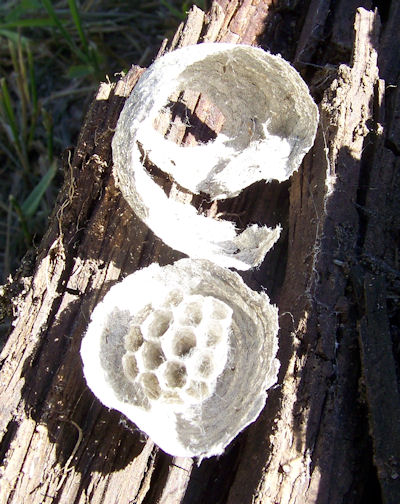
|
| This nest was found at the hightest point of the eaves of my
house in Colorado Springs on 13 June 2010. Getting it down destroyed it -- very fragile.
It looks the same as the one found on the bottom of a landscaping timber in June 2009,
but this one is not subterranean.
| 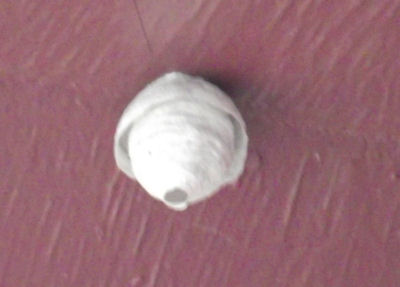
|
| Thread-waisted wasp. Pictures taken 4 August 2008.
Determining the species is usually done by an expert with an autopsy under a microscope.
The third picture was taken on 3 July 2012 in Cripple Creek, Teller Co., CO. It is probably
the same species as the other two, but still not narrowed down to genus and species.
Kingdom: Animalia
Phylum: Arthropoda
Class: Insecta
Order: Hymenoptera
Suborder: Apocrita
Superfamily: Apoidea
Family: Sphecidae (Digger wasps, mud daubers, etc)
Sub-Family: Ammophila (probably)
| 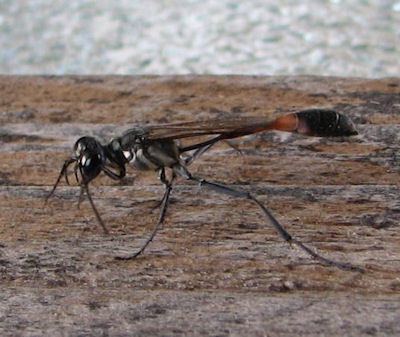
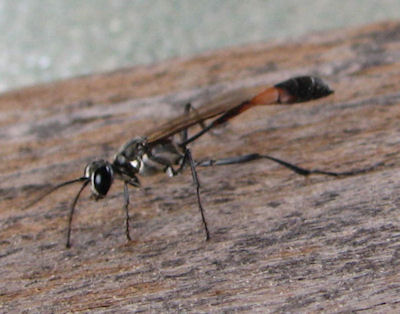
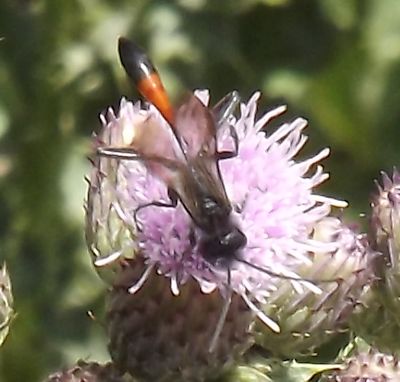
|
| Black and Yellow Mud dauber. This was found by Fountain Creek,
just west of Manitou Springs, CO. on 28 August 2009.
The second and third pictures show one found in my garage on 15 July 2011. It would not
pose for pictures, and was quite angry that I captured it, so I let
it calm down in my refrigerator for a while so I could get this
picture.
Kingdom: Animalia
Phylum: Arthropoda
Class: Insecta
Order: Hymenoptera
Family: Sphecidae
Genus: Sceliphron
Species: S. caementarium
| 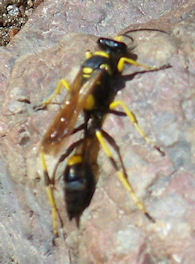
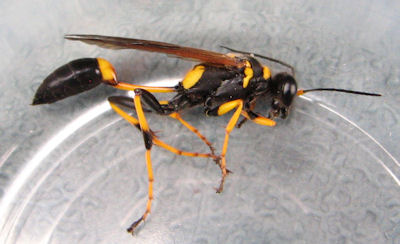
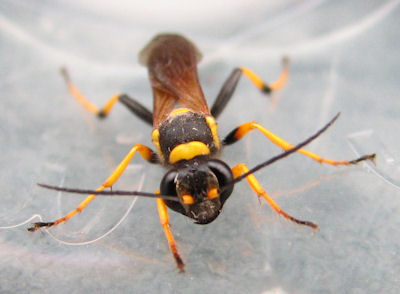
|
| I found this one on January 13 2010, on the wall of my garage, near the ceiling,
and in back of some boxes. I have no idea how long it had been there. It was about 1 inch long.
Mud daubers make this kind of housing for their larva, but usually several grouped together.
| 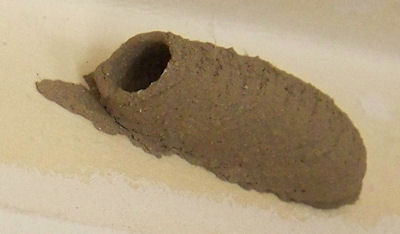
|
| These are called galls, and are made by a wasp called the Clustered Midrib Gall Wasp
(Adleria dimorpha). That partiular wasp
uses oak trees. These were found on the bottom side of a Scrub Oak, at the
Bear Creek Nature Center in Colorado Springs on 25 August 2010. There were quite a few of these,
and all seemed to be on the stem part of the leaves.
Kingdom: Animalia
Phylum: Arthropoda
Class: Insecta
Order: Hymenoptera
Suborder: Apocrita
Superfamily: Cynipoidea
Family: Cynipidae
Genus: Adleria
Species: dimorpha
| 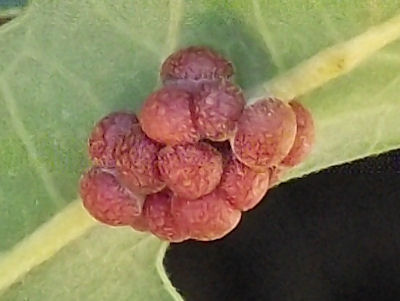
|
| This is also the work of a wasp,
but it is much larger than the cluster above.
So, identification has not been made yet.
This picture was taken on 1 Sept. 2010 at the same place as the cluster above,
also on a scrub Oak tree.
Kingdom: Animalia
Phylum: Arthropoda
Class: Insecta
Order: Hymenoptera
Suborder: Apocrita
Superfamily: Cynipoidea
Family: Cynipidae
| 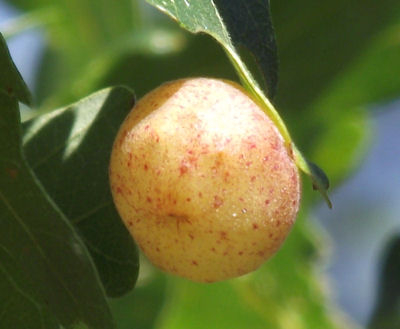
|
| These galls are on Willow trees at the Bear Creek Nature
Center in Colorado Springs, CO. They are caused by some insect
which has not been identified yet, but probably a wasp.
The pictures were taken on 22 June 2011.
| 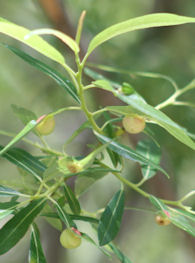
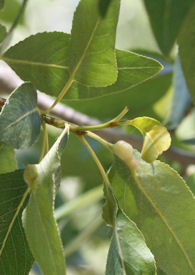
|
| These are more galls, this time on Willow leaves
found near Fountain Creek just west of Manitou Springs, CO.
Again, these are caused by some insect putting some chemicals on
the leaf of a plant, and the plant grows the gall in response.
The insect then places eggs in the gall. These pictures were taken
on 25 July 2011.
| 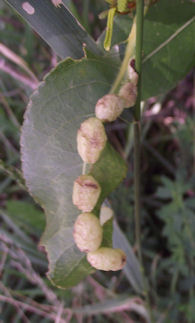
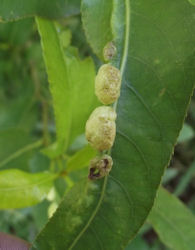
|
| This small wasp was found near Eleven Mile Lake on
18 August 2011. Identification has not been made.
It moved with the fast, jerky movements common in wasps.
| 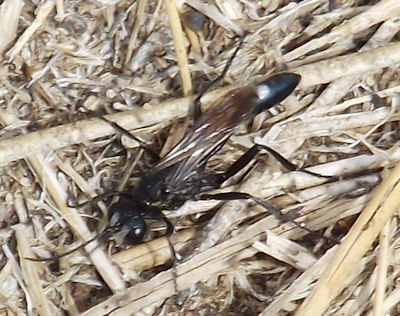
|















